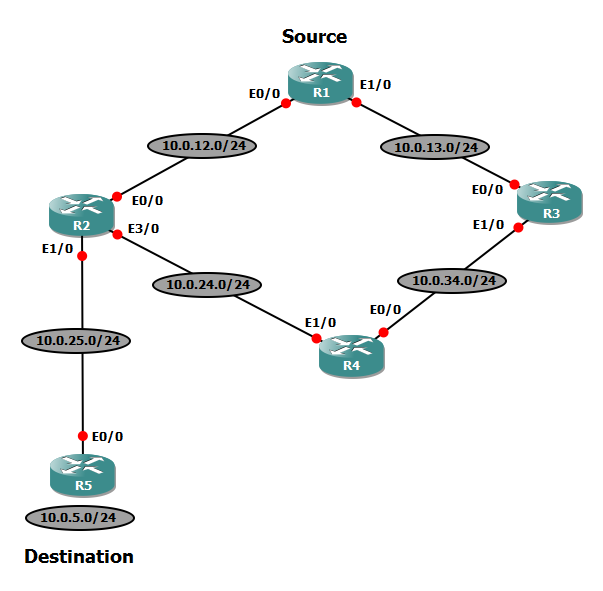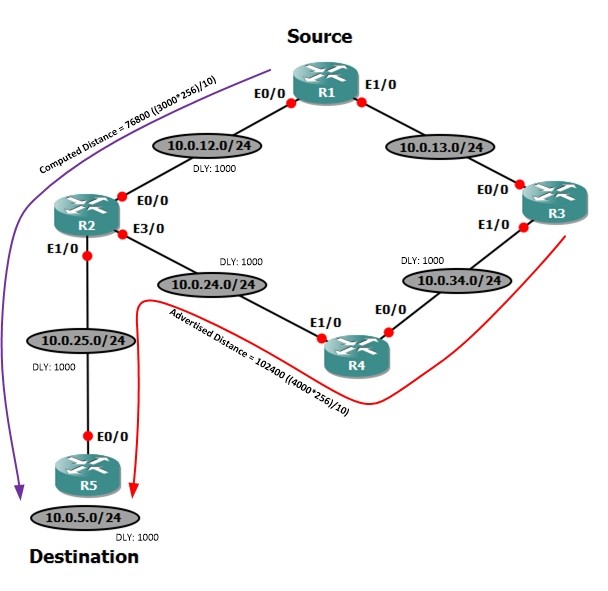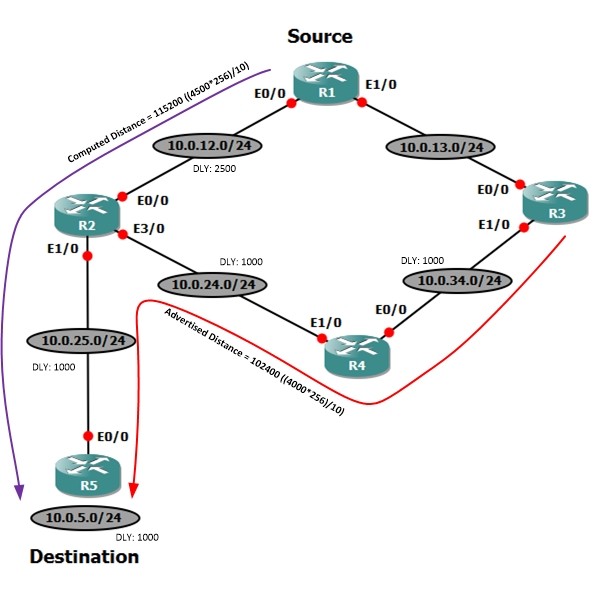EIGRP Lab 1: Unequal-Cost Load Balancing and Traffic Load
Lab Topology:

Overview
- The goal of this lab is from R1 perform unequal-cost load balancing to the 10.0.5.0/24 network hosted by R5
- All K values have been disabled with the exception of K3 therefore Successor and Feasible Successor paths are only based on the Delay metric
- All Delay values are set to their default of 1000ms
Tasks
- Ensure there is a Successor and Feasible Successor in R1’s Topology table
- On R1 make the traffic share of the Successor 8 times more than the other path
- Only change the Delay values on R1 to make this happen
Download initial lab:
GNS3 Topology
Solution
- The first problem is there is only one path in the Topology table in R1 pointing to R2.
- This is because the second path through R3 doesn’t meet the Feasibility Condition (FC):
- FC RULE: Neighbors Advertised Distance < Successor Computed Distance
- Successors Computed Distance = 76800 ((3000 x 256)/10)
- Neighbors Advertised Distance = 102400 ((4000 x 256)/10)
- 1024000 > 76800 therefore R1 can’t guarantee a loop-free path through R3

- To fix this we need to increase the delay on the Ethernet0/0 Interface towards R2
- Command:
- (config)#interface ethernet 0/0
- (config-if)#delay 250 (Although entered as 10’s of microseconds it is calculated as microseconds)
- If we increase the delay to 2500 this will put the Successor Computed Distance at 115200 ((4500*256)/10)
- This now meets the EIGRP Feasibility Condition
- Neighbors Advertised Distance < Successors Computed Distance
- 102400 ((4000*256)/10) < 115200 ((4500*256)/10)
- As a result looking under the EIGRP Topology table in R1 now shows a Feasible Successor for the network 10.0.5.0/24
- Command:
- #show ip eigrp topology 10.0.5.0/24

- The next problem is to perform the Unequal-Cost Load Balancing and ensuring the traffic share has a ratio of 9:1
- The traffic load is automatically calculated based on the metric value of the interfaces
- The calculation for this is Highest Path Metric / Path Metric
- Only really needed if there was more that 2 interfaces that required a distributed traffic load.
- At the moment we have a Successor route with a metric of 115200 ((4500*256)/10)
- As we can only edit the Delay value on R1 we need to do a calculation to get the Delay to go on interface Ethernet 1/0 towards R3.
- This is done using the following calculation:
- Take the Successors Computed Distance and times by 9 (traffic load)
- Take this calculated value and subtract the neighbors Advertised Distance
- Now we have the metric value we need to have on the link between R1 and R3, we need to divide by 256 to calcuale the interface delay value
- We now have the Delay value we need to put on the interface Ethernet 1/0
- The last bit of configuration is to enable the Feasible Successor to be installed in the routing table through the variance command
- Command:
- (config-router)#variance 8
- Now if you look at the routing table for 10.0.5.0 on R1 you will see 2 routes installed, one via R1 with a traffic count of 8 and one via R3 with traffic count of 1












